Sun
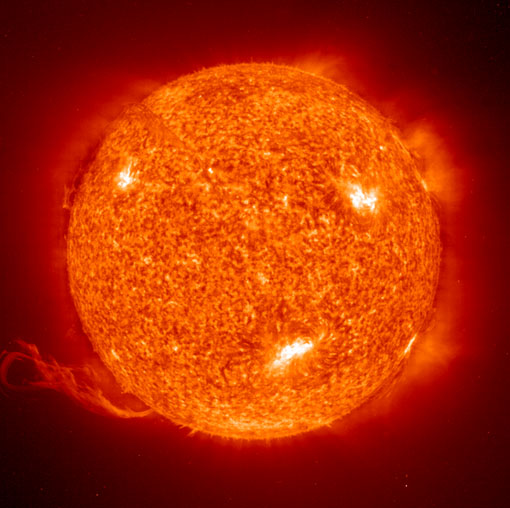
NASA image
Mass (Earth=1) 332,800 Mean diameter (106 m) 1392 Rotation period 26-37 d Mean distance to Earth, 106 km 149 Density (water=1) 1.41 Surface gravity m/s2 274
Earth's Sun is a medium-sized star which lies on the main sequence with 90% of the known stars. It has a effective surface temperature is 5780 K, putting it in spectral class G2. Its mass is 1.989 x 1030 kg and its mean radius is 6.96 x 108meters. The mass of the sun is over 99.8% of the mass of the entire known solar system, leading de Pater and Lissauer to refer lightly to the solar system as "the Sun plus some debris".
Another interesting item of perspective is that "95% of all stars are less massive than the sun"(Ward & Brownlee).
The sun radiates energy at the rate of 3.85 x1026 watts. Just outside the earth's atmosphere solar energy is received, assuming normal incidence, at the rate of 1340 watts per square meter.

| Mass (Earth=1) | 332,800 |
| Mean diameter (106 m) | 1392 |
| Rotation period | 26-37 d |
| Mean distance to Earth, 106 km | 149 |
| Density (water=1) | 1.41 |
| Surface gravity m/s2 | 274 |
Earth's Sun is a medium-sized star which lies on the main sequence with 90% of the known stars. It has a effective surface temperature is 5780 K, putting it in spectral class G2. Its mass is 1.989 x 1030 kg and its mean radius is 6.96 x 108meters. The mass of the sun is over 99.8% of the mass of the entire known solar system, leading de Pater and Lissauer to refer lightly to the solar system as "the Sun plus some debris".
Another interesting item of perspective is that "95% of all stars are less massive than the sun"(Ward & Brownlee).
The sun radiates energy at the rate of 3.85 x1026 watts. Just outside the earth's atmosphere solar energy is received, assuming normal incidence, at the rate of 1340 watts per square meter.
The orbit of Earth ranges from 1.47 to 1.52 x 1011 meters from the Sun. The average light travel time to the earth is 8.3 minutes.
The radius of the sun at 696,000 km is 109 times the Earth's radius. Its surface gravity is 274 m/s2 or 28.0 times that of the Earth. Its mean density is 1410 kg/m3 or 0.255 times the mean density of Earth.
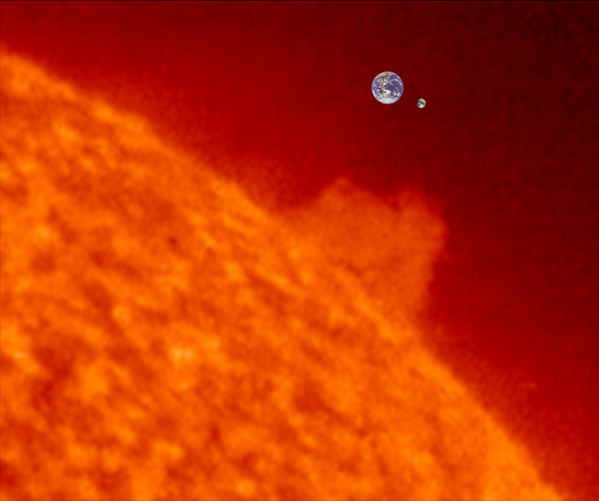
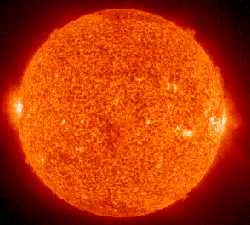
The Sun's diameter of 1,392,000 km is 109 times the Earth's equatorial diameter of 12,756 km. The distance to the Earth from the sun at 149,000,000 km = 1 AU is 107 times the diameter of the Sun and 388 times the Earth-Moon distance.
The Earth-Moon distance is not shown to scale in the above composite. The diameter of the Sun is 3.6 times the Earth-Moon distance. Above, the Earth and Moon are scaled relative to an image of the Sun made by the SOHOsatellite on January 12, 2007.
The composition of the sun is 71% hydrogen, 27.1% helium and less than 2% of all other elements. The center temperature is modeled to be 15.5 million K. The Sun is fueled by the proton cycle of nuclearfusion. Escape velocity = 618 km/s


The Sun's diameter of 1,392,000 km is 109 times the Earth's equatorial diameter of 12,756 km. The distance to the Earth from the sun at 149,000,000 km = 1 AU is 107 times the diameter of the Sun and 388 times the Earth-Moon distance.
The Earth-Moon distance is not shown to scale in the above composite. The diameter of the Sun is 3.6 times the Earth-Moon distance. Above, the Earth and Moon are scaled relative to an image of the Sun made by the SOHOsatellite on January 12, 2007.
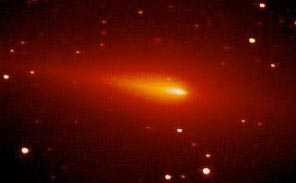
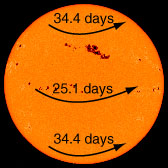
Being a gaseous body, the Sun does not have a single period of rotation like a rigid body. The sunspots provide a convenient reference for the measurement of the rotation period at different latitudes. The period of rotation averages 25.4 days, varying from 34.4 days at the poles to 25.1 days at the equator (Chaisson). Its axis is tilted 7.25° relative to the ecliptic.
The visible surface of the Sun (the photosphere) has a granular appearance with a typical dimension of a granule being 1000 kilometers. The image at right is from the NASA Solar Physics website and is credited to G. Scharmer and the Swedish Vacuum Solar Telescope. The granules are described as convection cells which transport heat from the interior of the Sun to the surface.
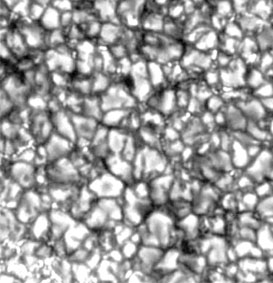
The Sun's apparent magnitude is -26.8 and its absolute magnitude is +4.8 . Its greatest angular diameter as seen from the Earth is 32.5' . The sun is 7.7 kpc or 25,000 light years from the center of the galaxy and orbits the galaxy in about 200 million years. This corresponds to an orbital velocity of 230 km/s.
Asteroids
Asteroids are minor planets, most of which orbit the Sun between Mars and Jupiter. Their orbits are typically more eccentric than those of the planets. The largest asteroid, Ceres, is 940 kilometers in diameter and has about 1/10000 the mass of the Earth. With over 7000 asteroids catalogued, the total number may exceed 100,000. However, their combined mass is less than 1/10 that of the Earth's Moon.
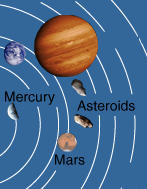
All solid bodies in our Solar System show craters where they have collided with asteroids and comets.
A few asteroids cross the Earth's orbit. The most notable of these are Apollo, Icarus, Adonis, and Eros. Hector has an orbit similar to that of Jupiter, and Hidalgo has a large elliptical orbit which extends from about the orbit of Mars out well beyond the orbit of Jupiter.
Asteroid Gaspra was used in slingshot maneuver with Galileo in 1991 on the way toward ultimate rendevouz with Jupiter. Galileo also provided a close view of asteroid Ida.
The vast majority of the meteorites that hit the Earth are thought to come from the asteroid belt.
Asteroids are classified from their observed reflectivity, with C-type asteroids making up about 75% of them. C-type or carbonaceous asteroids are dark from the high content of carbon in them. S-type asteroids contain silicate and are more reflective - they make up about 15% of the asteroids. Most of the remaining asteroids are called M-type and contain large fractions of iron and nickel. The C-type asteroids are supposed to be very primitive material that has not been significantly heated or changed chemically since they were formed some 4.6 billion years ago.
Comets
Comets are small asteroid-like bodies when they are far from the Sun, traveling in highly ellipical orbits about the Sun. When they sweep in close to the Sun, dramatic changes occur as they brighten and develop an extended tail. The nucleus is widely described as a "dirty snowball" composed of ice and some rocky debris.
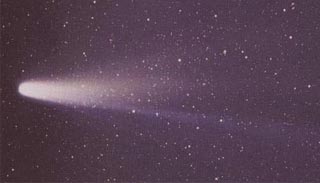
Halley's Comet
There is considerable vaporization as they approach the Sun and they develop ion tails and dust tails. The ion tails are almost straight streamers from the nucleus while the usually brighter dust tails are broad and diffuse and curve slightly, lagging behind the radial direction.
The lighter ionized gas atoms of the ion tale cause it to point outward, directly away from the Sun, because the influence of the solar wind is dominant. I take the lower, more focused part of the tail in the image above to be the ion tail. The dust tail is made up of more massive particles and the role of gravity is important. If particles influenced by gravity are moved to an orbit further from the Sun, their radial direction falls behind that of the nucleus of the comet because their orbital period will be longer.
The upper part of the Halley image would then appear to be the dust tail - you can see a slight curvature. In its most visible phase close to the Sun, the comet has a small solid nucleus and a ball of gas around it called the coma. Comas have been found to be on the order of 100,000 km in diameter at their maximum size, comparable to the largest planets. Most aof the light reflection is from the coma. Surrounding the coma and the visible tails is a hydrogen envelope which may extend millions of kilometers. The light from comets is purely reflected light; like the planets, the comets produce no light of their own.
Current models of the nuclei of comets view them as balls of loosely packed ices, a cold mixture containing gas and dust. The dust is thought to be trapped in a mixture of methane, ammonia, and water ice. The smaller moons of the outer solar system are similar in constitution. Since they spend most of their time far from the Sun, their temperatures are thought to be a few tens of kelvins. Chaisson & McMillan suggest a core temperature of 200K and a surface temperature on the order of 350K for Halley when it made its close approach to the Sun.
The short-period comets (less than 200 years) are thought to originate in a region of the solar system out past the orbit of Neptune called the Kuiper belt (30 to 100 AU). Most of them are found to have prograde orbits (in the same orbital direction as the planets) and to be close to the ecliptic plane. The Kuiper belt is described as a region of asteroid-like comets, most of which travel in roughly circular orbits. It may be that occasional close encounters between comets or the cumulative gravitational pull of the outer planets brings one into the higly elliptical orbit which brings it close to the Sun.
Other comets, characterized as "long-period comets", are found in random orientations with respect to the ecliptic plane. They are thought to originate in a large "cloud" of objects in a region perhaps 50,000 AU from the Sun called the Oort cloud.


Being a gaseous body, the Sun does not have a single period of rotation like a rigid body. The sunspots provide a convenient reference for the measurement of the rotation period at different latitudes. The period of rotation averages 25.4 days, varying from 34.4 days at the poles to 25.1 days at the equator (Chaisson). Its axis is tilted 7.25° relative to the ecliptic.
The visible surface of the Sun (the photosphere) has a granular appearance with a typical dimension of a granule being 1000 kilometers. The image at right is from the NASA Solar Physics website and is credited to G. Scharmer and the Swedish Vacuum Solar Telescope. The granules are described as convection cells which transport heat from the interior of the Sun to the surface.


A few asteroids cross the Earth's orbit. The most notable of these are Apollo, Icarus, Adonis, and Eros. Hector has an orbit similar to that of Jupiter, and Hidalgo has a large elliptical orbit which extends from about the orbit of Mars out well beyond the orbit of Jupiter.
Asteroid Gaspra was used in slingshot maneuver with Galileo in 1991 on the way toward ultimate rendevouz with Jupiter. Galileo also provided a close view of asteroid Ida.
The vast majority of the meteorites that hit the Earth are thought to come from the asteroid belt.

There is considerable vaporization as they approach the Sun and they develop ion tails and dust tails. The ion tails are almost straight streamers from the nucleus while the usually brighter dust tails are broad and diffuse and curve slightly, lagging behind the radial direction.
The upper part of the Halley image would then appear to be the dust tail - you can see a slight curvature. In its most visible phase close to the Sun, the comet has a small solid nucleus and a ball of gas around it called the coma. Comas have been found to be on the order of 100,000 km in diameter at their maximum size, comparable to the largest planets. Most aof the light reflection is from the coma. Surrounding the coma and the visible tails is a hydrogen envelope which may extend millions of kilometers. The light from comets is purely reflected light; like the planets, the comets produce no light of their own.
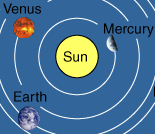
While the most famous comet is Halley's Comet, some interesting recent encounters have been with comet Giacobini-Zinner and the impact of cometShoemaker-Levy 9 on Jupiter.
This image of comet Schwassmann-Wachmann 3 taken by Tim Puckett of Villa Rica, Ga. USA. It was obtained with a 12" Lx200 working at f/7. This is a 300 second exposure taken on 12-01-95 .
Mercury
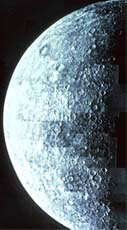
Mass (Earth=1) 0.0558 Equatorial diameter (km) 4880 Period (years) 0.241 Mean distance from Sun, 106 km 57.9 Density (water=1) 5.60 Surface gravity m/s2 3.78


| Mass (Earth=1) | 0.0558 |
| Equatorial diameter (km) | 4880 |
| Period (years) | 0.241 |
| Mean distance from Sun, 106 km | 57.9 |
| Density (water=1) | 5.60 |
| Surface gravity m/s2 | 3.78 |
The cliffs and craters (up to 800 miles across) of Mercury were first imaged by NASA's Mariner 10 which passed it at an estimated distance of 705 km on Mar 29, 1974. Mercury's wrinkled surface may be the result of the planet shrinking as it cooled after formation 4.5 billion years ago. Mariner 10 passed by again on Sep 21, 1974 at 48,069 km and a third time on Mar 16, 1975 at a distance of 307 km.
Next to the exceptional orbit of Pluto, Mercury has the orbit with the greatest eccentricity (e = .208) and the greatest inclination to the ecliptic plane ( 7°).
Mercury's small orbit keeps it so close to the Sun that, when viewed from Earth, Mercury is almost always seen in twilight. Mercury receives the maximum amount of sunlight, but its albedo is only 0.1 compared with 0.39 for the Earth, so it is not as bright as it would be with a higher albedo.
Venus
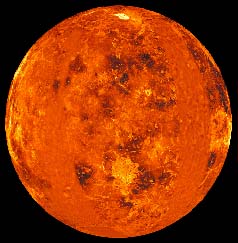
Mass (Earth=1) 0.815 Equatorial diameter (km) 12,100 Period (years) 0.615 Mean distance from Sun, 10^6 km 108 Density (water=1) 5.20 Surface gravity m/s^2 8.60

The brightest planet as seen from Earth, Venus swings from one side of the Sun to the other, alternating as our brilliant "Evening Star" and "Morning Star," each seen for about 8 months at a time.
Mercury's small orbit keeps it so close to the Sun that, when viewed from Earth, Mercury is almost always seen in twilight. Mercury receives the maximum amount of sunlight, but its albedo is only 0.1 compared with 0.39 for the Earth, so it is not as bright as it would be with a higher albedo.

| Mass (Earth=1) | 0.815 |
| Equatorial diameter (km) | 12,100 |
| Period (years) | 0.615 |
| Mean distance from Sun, 10^6 km | 108 |
| Density (water=1) | 5.20 |
| Surface gravity m/s^2 | 8.60 |

The brightest planet as seen from Earth, Venus swings from one side of the Sun to the other, alternating as our brilliant "Evening Star" and "Morning Star," each seen for about 8 months at a time.
The carbon dioxide atmosphere and sulfuric acid clouds of Venus allow sunlight in but don't let the heat back out, trapping it like the glass in a greenhouse and making Venus the hottest of planets. The flyby of Mariner 2in 1962 indicated a surface temperature of about 400 C. One of the discoveries of Mariner 2 was that Venus has no measurable magnetic field, even though its density indicates an iron core similar to that of the Earth.
The presumption is that its slow rotation (period 243 Earth days) is insufficient to create the kind of dynamo effect which produces the Earth's magnetic field. Mariner 5 passed closer to Venus, swinging by at 2900 km. Venus was used in a slingshot maneuver to boost Mariner 10 on toward Mercury on Feb 5, 1974.
Its closest approach to Venus was 5770 km. The exploration of the atmosphere and surface of Venus was a major goal of the Russian space program in their extended Venera series of spacecraft. The Venera explorations provide the only direct data we have on the surface of Venus. The Magellan orbiter provided a much more detailed radar map of the surface than the previous explorations, bringing the number of Venus exporation missions to about 20.
Earth
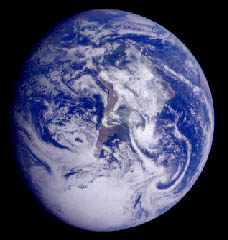
Mass (Earth=1) 1.00 Equatorial diameter (km) 12,800 Period (years) 1.00 Mean distance from Sun, 106km 150 Density (water=1) 5.52 Surface gravity m/s2 9.78

Earth is the only planet with liquid water on its surface. In fact, 70% of the Earth is covered by water.
Our oceans and air were formed by gases seeping from the Earth as it cooled after formation. Fossils indicate that life began on Earth at least 3.5 billion years ago.
Mars
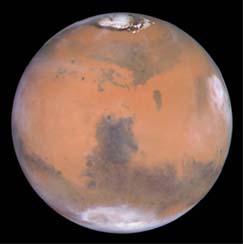
Mass (Earth=1) 0.107 Equatorial diameter (km) 6,790 Period (years) 1.88 Mean distance from Sun, 10^6 km 228 Density (water=1) 3.95 Surface gravity m/s^2 3.72
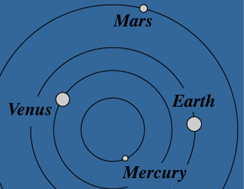
The Red Planet features ice caps of carbon dioxide and water, a volcano 15 miles high (Olympus Mons), a canyon 3,000 miles long and 4 miles deep (the great rift valley, Valles Marinerus), and dry river channels. Many such features were explored in 1971-72 by the Mariner-9 craft.
The later Viking landers performed surface tests, looking for evidence of life.
Perhaps Mars, now locked in an ice age, once had a denser atmosphere and liquid water on its surface. But NASA's two
Viking landers (1976) found no life.

| Mass (Earth=1) | 1.00 |
| Equatorial diameter (km) | 12,800 |
| Period (years) | 1.00 |
| Mean distance from Sun, 106km | 150 |
| Density (water=1) | 5.52 |
| Surface gravity m/s2 | 9.78 |

Earth is the only planet with liquid water on its surface. In fact, 70% of the Earth is covered by water.
Our oceans and air were formed by gases seeping from the Earth as it cooled after formation. Fossils indicate that life began on Earth at least 3.5 billion years ago.

| Mass (Earth=1) | 0.107 |
| Equatorial diameter (km) | 6,790 |
| Period (years) | 1.88 |
| Mean distance from Sun, 10^6 km | 228 |
| Density (water=1) | 3.95 |
| Surface gravity m/s^2 | 3.72 |

The Red Planet features ice caps of carbon dioxide and water, a volcano 15 miles high (Olympus Mons), a canyon 3,000 miles long and 4 miles deep (the great rift valley, Valles Marinerus), and dry river channels. Many such features were explored in 1971-72 by the Mariner-9 craft.
The later Viking landers performed surface tests, looking for evidence of life.
Perhaps Mars, now locked in an ice age, once had a denser atmosphere and liquid water on its surface. But NASA's two
Viking landers (1976) found no life.
Moons of Mars
Jupiter
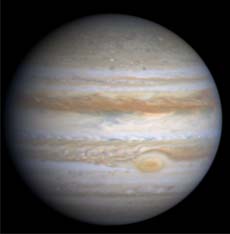
| 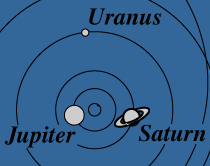 With over twice as much mass as all the other planets and moons combined, Jupiter still has 50 times too little mass to be a star. It is 318 times as massive as the Earth. It is mostly composed of hydrogen and helium, but is thought to have a heavy element core on the order of 10 times the mass of the Earth. The Great Red Spot, larger than two Earths, rages like a hurricane in Jupiter's turbulent atmosphere. Heat from Jupiter's 29,700°C (53,500°F) core keeps the atmosphere churning. Voyager photographs showed extensive lightning activity in the atmosphere of Jupiter, and uv photographs indicate auroral activity. |
| The small rocky moons of Mars, Deimos and Phobos, are irregular in shape and comparable in size to the asteroid Gaspra. The three objects are shown at the same scale and almost the same lighting conditions in the image linked below. All three bodies have irregular shapes, testament to their violent histories. Their surfaces are distinctly different, most likely because of very different impact histories. The Gaspra image was taken by the Galileo spacecraft on October 29, 1991 and the images of Deimos and Phobos were taken by VikingOrbiter in 1977. The images are from NASA. |
Jupiter's Moons

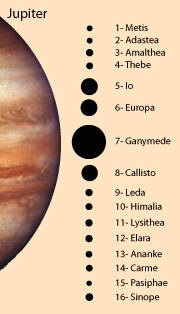 |
| |||||||||||||||||||||||||||||||||||||||||||||||||||||||||||||||||||||||||||||||||||||||||
| The four largest moons are comparable to the Earth's Moon in size. They are referred to as the Galilean moons. Their orbits are direct (in the same direction as the planet's rotation), their orbits are roughly circular, and they lie close to Jupiter's equatorial plane. Io and Europa have thick rocky mantles surrounding iron/iron sulfide cores. Ganymede and Callisto are less dense, with water and water ice accounting for as much as half of their masses. Ganymede does have a small metallic core, as evidenced by the fact that it has a magnetic field, but Callisto is apparently a largely undifferentiated mixture of rock and ice. | Additional Data for the Galilean Moons
|
The outer moons are in two groups of four each at about the same orbit radius. The moons of the inner group move in eccentric, inclined orbits at about 11 million kilometers, and those of the outer group move in eccentric orbits at about 22 million kilometers which are retrograde to the planets rotation. It is likely that each group came from the breakup of a single body which was captured by Jupiter's gravity.
Saturn
A gas giant like Jupiter, Saturn is the least dense of all the planets, 70% as dense as water. If Saturn could be dropped into a gigantic tub of water, it would float. Saturn, like Jupiter, is mostly composed of hydrogen and helium, but is thought to have a heavy element core on the order of10 times the mass of the Earth.
 Saturn's ring system is visible with a small telescope. NASA's Voyager space-probes revealed that the rings number more than a thousand. Present understanding is that the rings did not form with the planet but are the remains of a shattered moon or comet, formed some 100 million years ago.
Saturn's ring system is visible with a small telescope. NASA's Voyager space-probes revealed that the rings number more than a thousand. Present understanding is that the rings did not form with the planet but are the remains of a shattered moon or comet, formed some 100 million years ago.
The great ring is a "disk more than 180,000 miles wide but scarcely 60 ft high, making it many orders of magnitude flatter than a pancake. Ring researchers compare it to a sheet of tissue paper spread across a football field." Sobel
|
Saturn's Moons
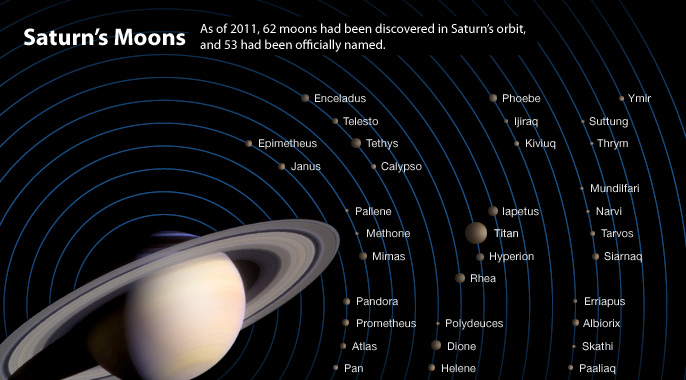
Our knowledge of the moons of Saturn was greatly increased by the Cassini Mission.Iapetus shows a brightness variation of a factor of 10, a change in intensity believed to be caused by the existence of ice on one side and black carbonaceous material on the other. ( Weisburd, Science News 133, June 11, 1988 p374) Enceladus has a heavily cratered surface; it was imaged clearly in the Voyager program.
The moons Hyperion, Epimetheus and Dione were also imaged by Cassini. References:Cassini Mission Wiki Moons of Saturn "Alien-life hunters focus on moons in outer solar system", Nadia Drake, Science News 180, #8, Oct 8
 |
Saturn's ring system is visible with a small telescope.
A gas giant like Jupiter, Saturn is the least dense of all the planets, 70% as dense as water. If Saturn could be dropped into a gigantic tub of water, it would float. Saturn, like Jupiter, is mostly composed of hydrogen and helium, but is thought to have a heavy element core on the order of10 times the mass of the Earth.
NASA's Voyager space-probes revealed that the rings number more than a thousand. Present understanding is that the rings did not form with the planet but are the remains of a shattered moon or comet, formed some 100 million years ago.
The great ring is a "disk more than 180,000 miles wide but scarcely 60 ft high, making it many orders of magnitude flatter than a pancake. Ring researchers compare it to a sheet of tissue paper spread across a football field." Sobel
Uranus

|  Uranus is the only planet which lies on its side as it revolves around the Sun. Because it is at the limit of naked eye visibility, Uranus was unknown until William Herschel discovered it with a telescope in 1781. The rings were revealed when they occulted a star in 1977. Uranus and Neptune are sometimes referred to as the "ice giants", their compositions being dominated by water, ammonia (NH3), methane (CH4)' and some 'rock" composed of silicates and metals. They have a hydrogen/helium atmosphere which is thought to have a mass of around 1 - 3 times the mass of the Earth. |
Uranus' Moons
 | The image of Uranus' moon Miranda is a computer-assembled mosaic of images obtained on Jan 24, 1986 by the Voyager 2 spacecraft. Miranda is the innermost and smallest of the five major Uranian satellites, just 480 km (300 mi) in diameter. Nine images were combined to obtain this full-disc, south polar view, which shows the varying geologic provinces of Miranda. Miranda's surface consists of two strikingly different major types of terrain. One is an old, heavily cratered, rolling terrain with relatively uniform albedo (reflectivity). The other is a young, complex terrain characterized by sets of bright and dark bands, scarps and ridges - features found in the regions at right and left and in the distinctive "chevron" feature below and right of center. |
Neptune
 |
Neptune is a near twin of Uranus in size, one of the gas giants.
Neptune was discovered mathematically before it was seen telescopically. The varying orbital speeds of Uranus allowed J.C. Adams and J. J. Leverrier to calculate in 1845 that an unknown planet was affecting Uranus gravitationally. In 1846, J. Galle found Neptune where the mathematicians predicted it.
|
Pluto
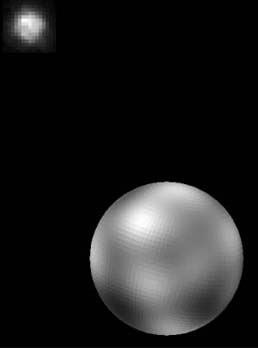
| 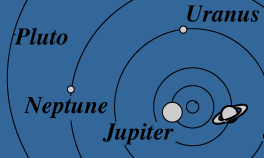 Pluto was discovered by C. Tombagh in 1930, using the same techniques by which Neptune was found. But Pluto, much smaller than expected, is too tiny to affect faraway Uranus, so it's discovery was an accident. Pluto's moon is a surprising one-third the diameter of Puto . Both may be escaped satellites of Neptune. Pluto's orbit is unique in that it is much more elliptical than the other planets, and it is inclined 17° to the plane of the Earth's orbit. |



Sem comentários:
Enviar um comentário